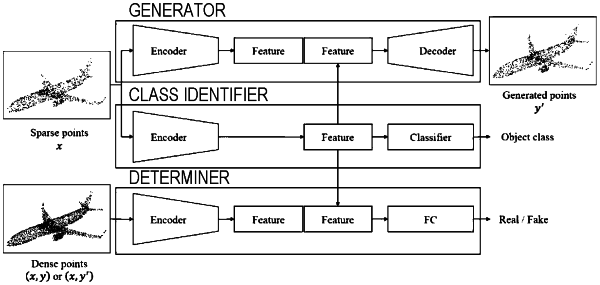| CPC G06T 7/50 (2017.01) [G06F 18/24 (2023.01); G06T 19/20 (2013.01); G06V 10/40 (2022.01); G06T 2207/10024 (2013.01); G06T 2207/10028 (2013.01); G06T 2207/20081 (2013.01); G06T 2207/20084 (2013.01); G06T 2207/20212 (2013.01); G06T 2210/56 (2013.01); G06T 2219/2021 (2013.01)] | 17 Claims |

|
1. A shape completion device comprising a processor configured to execute a method comprising:
inputting an input point cloud to a learning model, wherein the input point cloud includes a plurality of input points, wherein the learning model is trained using learning data, the learning data includes a learning input point cloud and a teacher point cloud, the learning input point cloud includes a set of sparse three-dimensional points representing a part of a shape of an object, and the teacher point cloud completes an output shape based on the learning input point cloud;
determining, based on the input point cloud, a class identification feature of a class, wherein the class is associated with the object; and
generating, based on the input point cloud and the class identification feature, a shape completion point cloud,
wherein the generating the shape completion point cloud further comprises:
determining a combination of parameters including a parameter associated with the generating the shape completion point cloud and a parameter associated with determining whether the set of sparse three-dimensional points is a true point cloud, wherein the determining the combination of parameters further comprises optimizing a loss function, and the loss function is based at least on:
a determination result from the determining whether a set of three-dimensional points that includes the input point cloud and the teacher point cloud are combined is a true point cloud,
a determination result from the determining whether a set of three-dimensional points that includes the input point cloud and the shape completion point cloud is a true point cloud, and
a distance between the shape completion point cloud and the teacher point cloud, and
wherein the shape completion point cloud includes a set of three-dimensional points, wherein the generating the shape completion point cloud further includes obtaining an integration result, and wherein the integration result is obtained by steps including:
determining, based on local features associated with respective points of the input point cloud, a global feature associated with the input point cloud,
integrating the global feature with the class identification feature, and
convoluting the integration result to determine a missing portion of the object and to generate the shape completion point cloud associated with the input point cloud.
|